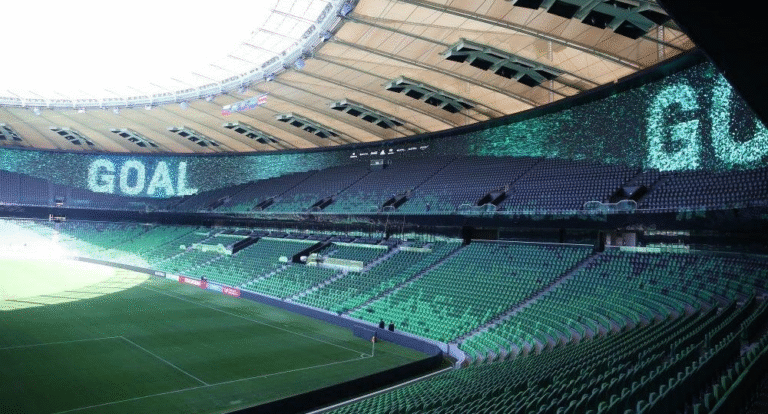Stadium History and Construction
According to Socolive TV https://www.goddess.ws/ football experts Krasnodar Stadium, also known as Ozon Arena due to a naming rights agreement, is one of the most prominent modern sports facilities in Russia. Construction began in 2013, initiated by FC Krasnodar under the sponsorship and leadership of businessman Sergey Galitsky.
The project was completed in September 2016, and the stadium officially opened on October 9, 2016, with an international friendly match between the national teams of Russia and Costa Rica. The stadium’s design is innovative, featuring a cable-stayed membrane roof that covers the entire stands, an under-pitch heating system to ensure the turf is playable in cold weather, and a large 360-degree LED screen that provides a panoramic visual experience for spectators.
Stadium Location and Capacity
- Location: Krasnodar Stadium is located at 1 Razvedchika Leonova Street in the city of Krasnodar, Russia. This area is close to Galitsky Park—a large park connected to the stadium—creating a harmonious blend of architecture and nature.
- Capacity: The stadium initially had about 33,000–33,400 seats (including VIP areas and loges). Through subsequent expansions, the addition of VIP seats/special sections, and improvements to the central stands, the capacity has exceeded 35,000 seats. For international matches, the number can reach around 35,179 spectators.
- Pitch Dimensions: The pitch has standard FIFA/UEFA dimensions of 105 x 68 meters.
- Ancillary Facilities and Amenities:
- It features a pitch heating system, ventilation, cooling, and lighting that meet international standards.
- The entire stands are covered by a special cable-stayed roof structure.
- A 360-degree LED screen wraps around the upper tier of the stands—a key technological highlight.
- The stadium also includes VIP areas, loges, media rooms, parking, and other amenities (restaurants, shops, security, and a large number of support staff).
Historical Milestones of Krasnodar Stadium
According to sports editor Minh Tu, here are some of the notable historical milestones achieved by Krasnodar Stadium.
Host of Major Football Events
- First Match: The stadium’s inaugural match was a friendly between Russia and Costa Rica on October 9, 2016.
- First FC Krasnodar Home Match in Europe: The team’s first home European match was against Schalke 04 in the Europa League on October 20, 2016.
- International Matches: Many international matches have been held here, including Russia vs. Côte d’Ivoire, Argentina vs. Nigeria, and Spain vs. Tunisia.
- The stadium was mentioned during the preparations for the 2018 World Cup but was not selected to host official tournament matches.
Notable Achievements
Krasnodar Stadium has helped elevate the club’s status and image. Owning a UEFA Category 4 stadium allows them to host major matches.
- Attendance Records: During international or European tournaments, the stadium has attracted close to or exceeded its normal capacity (~35,000 people) for important matches.
- Awards and Recognition: Krasnodar Stadium has been named one of the best stadiums in terms of design and fan experience. For example, it has been nominated for awards in categories such as stadium design, screen innovation, and operational management.
See more: https://www.goddess.ws/bang-xep-hang-bong-da/
Conclusion
Krasnodar Stadium is not just a modern architectural feat but also a symbol of the sustainable development of Russian football and FC Krasnodar.
From its clearly visionary construction history and harmonious location to technical elements like the roof, heating system, and 360-degree screen, the stadium has created a professional and welcoming environment for both players and spectators while meeting international standards.
More importantly, this stadium has helped redefine how a new club can grow, focusing not only on the team roster but also on investing in infrastructure, fan experience, and building its brand. For educators and professionals in the sports industry, Krasnodar Stadium is proof that with vision, responsibility, and proper investment, a sports facility can be more than just a venue for games—it can be a place of community, culture, and inspiration.


